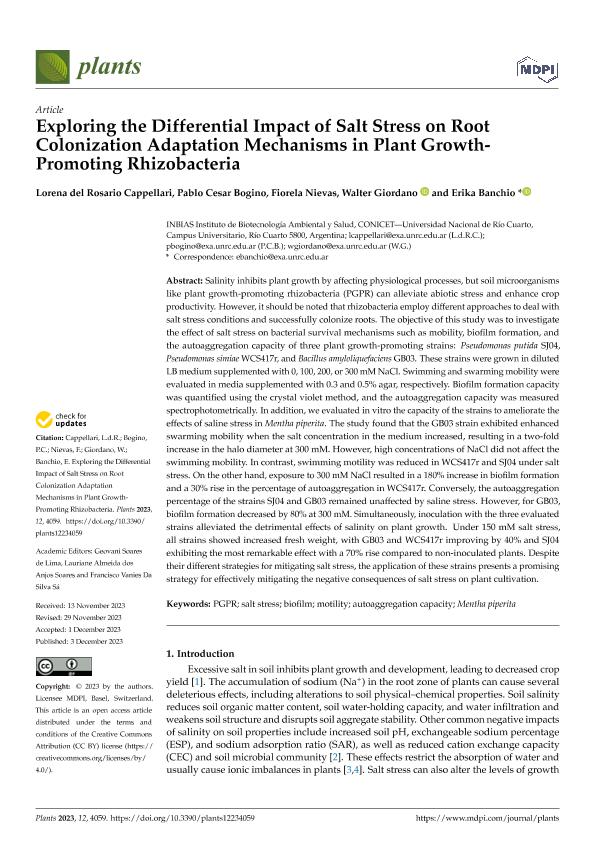Mostrar el registro sencillo del ítem
dc.contributor.author
Cappellari, Lorena del Rosario

dc.contributor.author
Bogino, Pablo Cesar

dc.contributor.author
Nievas, Fiorela Lujan

dc.contributor.author
Giordano, Walter Fabian

dc.contributor.author
Banchio, Erika

dc.date.available
2024-02-15T12:15:46Z
dc.date.issued
2023-12
dc.identifier.citation
Cappellari, Lorena del Rosario; Bogino, Pablo Cesar; Nievas, Fiorela Lujan; Giordano, Walter Fabian; Banchio, Erika; Exploring the Differential Impact of Salt Stress on Root Colonization Adaptation Mechanisms in Plant Growth-Promoting Rhizobacteria; Multidisciplinary Digital Publishing Institute; Plants; 12; 23; 12-2023; 1-16
dc.identifier.uri
http://hdl.handle.net/11336/227027
dc.description.abstract
Salinity inhibits plant growth by affecting physiological processes, but soil microorganisms like plant growth-promoting rhizobacteria (PGPR) can alleviate abiotic stress and enhance crop productivity. However, it should be noted that rhizobacteria employ different approaches to deal with salt stress conditions and successfully colonize roots. The objective of this study was to investigate the effect of salt stress on bacterial survival mechanisms such as mobility, biofilm formation, and the autoaggregation capacity of three plant growth-promoting strains: Pseudomonas putida SJ04, Pseudomonas simiae WCS417r, and Bacillus amyloliquefaciens GB03. These strains were grown in diluted LB medium supplemented with 0, 100, 200, or 300 mM NaCl. Swimming and swarming mobility were evaluated in media supplemented with 0.3 and 0.5% agar, respectively. Biofilm formation capacity was quantified using the crystal violet method, and the autoaggregation capacity was measured spectrophotometrically. In addition, we evaluated in vitro the capacity of the strains to ameliorate the effects of saline stress in Mentha piperita. The study found that the GB03 strain exhibited enhanced swarming mobility when the salt concentration in the medium increased, resulting in a two-fold increase in the halo diameter at 300 mM. However, high concentrations of NaCl did not affect the swimming mobility. In contrast, swimming motility was reduced in WCS417r and SJ04 under salt stress. On the other hand, exposure to 300 mM NaCl resulted in a 180% increase in biofilm formation and a 30% rise in the percentage of autoaggregation in WCS417r. Conversely, the autoaggregation percentage of the strains SJ04 and GB03 remained unaffected by saline stress. However, for GB03, biofilm formation decreased by 80% at 300 mM. Simultaneously, inoculation with the three evaluated strains alleviated the detrimental effects of salinity on plant growth. Under 150 mM salt stress, all strains showed increased fresh weight, with GB03 and WCS417r improving by 40% and SJ04 exhibiting the most remarkable effect with a 70% rise compared to non-inoculated plants. Despite their different strategies for mitigating salt stress, the application of these strains presents a promising strategy for effectively mitigating the negative consequences of salt stress on plant cultivation.
dc.format
application/pdf
dc.language.iso
eng
dc.publisher
Multidisciplinary Digital Publishing Institute
dc.rights
info:eu-repo/semantics/openAccess
dc.rights.uri
https://creativecommons.org/licenses/by/2.5/ar/
dc.subject
AUTOAGGREGATION CAPACITY
dc.subject
BIOFILM
dc.subject
MENTHA PIPERITA
dc.subject
MOTILITY
dc.subject
PGPR
dc.subject
SALT STRESS
dc.subject.classification
Biología Celular, Microbiología

dc.subject.classification
Ciencias Biológicas

dc.subject.classification
CIENCIAS NATURALES Y EXACTAS

dc.title
Exploring the Differential Impact of Salt Stress on Root Colonization Adaptation Mechanisms in Plant Growth-Promoting Rhizobacteria
dc.type
info:eu-repo/semantics/article
dc.type
info:ar-repo/semantics/artículo
dc.type
info:eu-repo/semantics/publishedVersion
dc.date.updated
2024-02-14T11:45:34Z
dc.identifier.eissn
2223-7747
dc.journal.volume
12
dc.journal.number
23
dc.journal.pagination
1-16
dc.journal.pais
Suiza

dc.journal.ciudad
Basilea
dc.description.fil
Fil: Cappellari, Lorena del Rosario. Universidad Nacional de Rio Cuarto. Facultad de Cs.exactas Fisicoquimicas y Naturales. Instituto de Biotecnologia Ambiental y Salud. - Consejo Nacional de Investigaciones Cientificas y Tecnicas. Centro Cientifico Tecnologico Conicet - Cordoba. Instituto de Biotecnologia Ambiental y Salud.; Argentina
dc.description.fil
Fil: Bogino, Pablo Cesar. Universidad Nacional de Rio Cuarto. Facultad de Cs.exactas Fisicoquimicas y Naturales. Instituto de Biotecnologia Ambiental y Salud. - Consejo Nacional de Investigaciones Cientificas y Tecnicas. Centro Cientifico Tecnologico Conicet - Cordoba. Instituto de Biotecnologia Ambiental y Salud.; Argentina
dc.description.fil
Fil: Nievas, Fiorela Lujan. Universidad Nacional de Rio Cuarto. Facultad de Cs.exactas Fisicoquimicas y Naturales. Instituto de Biotecnologia Ambiental y Salud. - Consejo Nacional de Investigaciones Cientificas y Tecnicas. Centro Cientifico Tecnologico Conicet - Cordoba. Instituto de Biotecnologia Ambiental y Salud.; Argentina
dc.description.fil
Fil: Giordano, Walter Fabian. Universidad Nacional de Rio Cuarto. Facultad de Cs.exactas Fisicoquimicas y Naturales. Instituto de Biotecnologia Ambiental y Salud. - Consejo Nacional de Investigaciones Cientificas y Tecnicas. Centro Cientifico Tecnologico Conicet - Cordoba. Instituto de Biotecnologia Ambiental y Salud.; Argentina
dc.description.fil
Fil: Banchio, Erika. Universidad Nacional de Rio Cuarto. Facultad de Cs.exactas Fisicoquimicas y Naturales. Instituto de Biotecnologia Ambiental y Salud. - Consejo Nacional de Investigaciones Cientificas y Tecnicas. Centro Cientifico Tecnologico Conicet - Cordoba. Instituto de Biotecnologia Ambiental y Salud.; Argentina
dc.journal.title
Plants
dc.relation.alternativeid
info:eu-repo/semantics/altIdentifier/url/https://www.mdpi.com/2223-7747/12/23/4059
dc.relation.alternativeid
info:eu-repo/semantics/altIdentifier/doi/https://doi.org/10.3390/plants12234059
Archivos asociados
